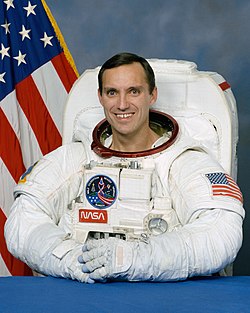Selected by NASA in January 1990, Walz is a veteran of four space flights, and has logged 231 days in space. He was a mission specialist on STS-51 (1993), was the Orbiter flight engineer (MS-2) on STS-65 (1994), was a mission specialist on STS-79 (1996), and served as flight engineer on ISS Expedition 4 (2001–2002).
Space flight experience
STS-51 Discovery (12–22 September 1993). During the mission, the five-member crew deployed the U.S. Advanced Communications Technology Satellite (ACTS), and the Shuttle Pallet Satellite (SPAS) with NASA and German scientific experiments aboard. Walz also participated in a 7-hour spacewalk (EVA) to evaluate tools for the Hubble Space Telescope servicing mission. The mission was accomplished in 9 days, 22 hours, and 12 minutes. [7]
STS-65 Columbia (8–23 July 1994). STS-65 flew the second International Microgravity Laboratory (IML-2) Spacelab module and carried a crew of seven. During the 15-day flight, the crew conducted more than 80 experiments focusing on materials and life sciences research in microgravity. The mission completed 236 orbits of the Earth, traveling 6.1 million miles, setting a new flight duration record for the Shuttle program. [8]
STS-79 Atlantis (16–26 September 1996). On STS-79 the six-member crew aboard Atlantis docked with the Russian Mir station, delivered food, water, U.S. scientific experiments and Russian equipment, and exchanged NASA long duration crewmembers. During the mission, the Atlantis/Mir complex set a record for docked mass in space. STS-79 was the first flight of the double Spacehab module and landed at KSC after 10 days 3 hours and 13 minutes. [9]
The Expedition 4 crew launched on 5 December 2001, aboard STS-108 and docked with the International Space Station on 7 December 2001. During a 6½ month stay aboard the Space Station, the crew of three (two American astronauts and one Russian cosmonaut) performed flight tests of the station hardware, conducted internal and external maintenance tasks, and developed the capability of the station to support the addition of science experiments. Wearing the Russian Orlan space suit, Walz logged 11 hours and 52 minutes of EVA time in two separate spacewalks. The Expedition 4 crew returned to Earth aboard STS-111, with Endeavour landing at Edwards Air Force Base, California, on 19 June 2002. [10]
With the Expedition 4 mission, Astronauts Bursch and Walz set a new U.S. space endurance record of 195 days 16 hours 33 minutes when they beat the old mark of 188 days set by astronaut Shannon Lucid aboard the Russian Mir space station in 1996. [10]
